|  he public interest in toys typical for differ nations and
times has been rapidly growing in recent period. The ever-accelerating
tempo of contemporary life makes the humans realize that
their childhood experiences and impressions have shaped
the most intimate components of their personalities. However,
access to them is tightly blocked by the barriers built
by education, so conventions, and adult life experiences
that not easy to leap over. The interest is manifesto the
increasing number of exhibitions, gal shows, sale drives
and other events presenting wide variety of toys ranging
from traditional art play things to custom-made porcelain
dolls, including such specialized exhibitions as, instance,
a show of all kinds of Barbie dolls.
he public interest in toys typical for differ nations and
times has been rapidly growing in recent period. The ever-accelerating
tempo of contemporary life makes the humans realize that
their childhood experiences and impressions have shaped
the most intimate components of their personalities. However,
access to them is tightly blocked by the barriers built
by education, so conventions, and adult life experiences
that not easy to leap over. The interest is manifesto the
increasing number of exhibitions, gal shows, sale drives
and other events presenting wide variety of toys ranging
from traditional art play things to custom-made porcelain
dolls, including such specialized exhibitions as, instance,
a show of all kinds of Barbie dolls.
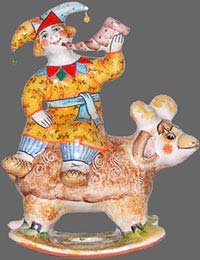
"Skomorokh on the sheep"
Yaroslavl majolica. 2001
|
The contemporary
Russian culture is unique that it simultaneously sustains
age-old folk and crafts and modem art trends, which stem
from and develop folk traditions. Craftsmen are
manufacturing folk toys in traditional styles and materials
while the best custom-made toys car regarded as masterpieces
of modern art.
In June 2001 the Foundation
of Folk Arts Crafts of the Russian Federation located at
7 Leontievsky Lane in Moscow held a large exhibition entitled
"Russian Toys. Past and Present”, exhibition
featured traditional Russian toys made of wood, ceramic,
birch bark, straws, and rags in styles that originated in
ancient times.
The well-known patrons of arts, the wealthy merchant families
of Morozov and Mamontov, were especially interested in folk
arts and crafts. The family of Anatoly Mamontov settled
in the Leontievsky Lane in the second half of the 19th century.
In the eighties of the 19th century his brother, Savva Mamontov,
a rich industrialist and an ardent arts-lover, supported
a circle of modem painters, musicians, and sculptors, based
at his country estate of Abramtsevo. He generously funded
their attempts to revive what they referred to as the "Russian"
style in arts, primarily in decorative arts and furnishings.
Similar aspirations guided his brother Anatoly when he opened
a so-called "workshop-store "Children's Education"
in his house in the Leontievsky Lane. Popular items in the
workshop were the so-called ethnographic dolls dressed in
holiday costumes typical for different regions and various
ethnic groups of the Russian Empire.
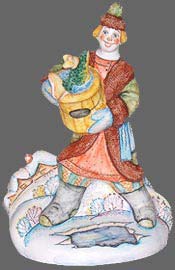
"Emelya and Pike"
Yaroslavl majolica. 2003
|
The toy-making
trade was in a deep crisis in the first years after the
establishment of the Soviet regime in Russia. The demand
for toys sharply dropped during the years of revolutionary
upheavals and the civil war. At the same time, the toys
handmade by craftsmen were intensely pushed out from the
market by the factory-made dolls and the mass-produced metal
toys.
Luka Kotikov, the renowned toy craftsmen from the village
of Fedoseevo (Nizny Novgorod region), made a defiant demonstration
of his unhappiness with the state of the toy trade by staging
a comical "funeral" of himself. He declared that
he had "nothing to live for if toys are no longer needed".
After a symbolically staged funeral of himself at a cemetery
that was almost across the road from his house he erected
on his "grave" a monument with the inscription
that L.Kotikov was buried there. The monument was a toy
windmill with images of the characters from children's fairy
tales on its vanes.
With time there was a gradual renewal of the interest in
the toys, in particular, toys from the
rural regions. In the Soviet period that started in 1917
and ended in the late eighties the handmade toy trade prospered
largely at the centers of folk arts and crafts. The privately
owned toy workshops and independent craftsmen manufacturing
traditional toys were obliged to join folk arts and crafts
cooperatives or state-owned enterprises under the Soviet
regime.
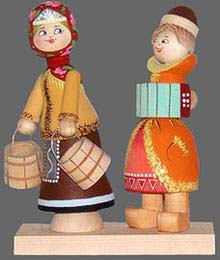
"Once a Maiden was walking for water"
Tver toy 2000
|
Democratic
reforms of the Soviet regime in the late 80s of the 20th
century initiated a revolutionary change in the social and
economic relations in the country. The newly found freedom
of expression changed radically the arts scene. In particular,
the situation in the decorative arts has grown to become
quite similar to that of a hundred years back when the so-called
Russian style was flourishing. Thus a new period began in
the evolution of the art of the hand-made toy in Russia.
At the first stage of reforms many designers and craftsmen
strove to revive the old toy styles and motifs that had
disappeared for a variety of reasons in the Soviet period.
The ancient Russian city of Tver is famous for its rich folk arts traditions.
The new art toys made by Tver craftsmen from wood and textiles in the recent
period exhibit an impressive creativity and profound awareness of the ancient
Russian culture. Many collectors of the handmade Russian toys have acquired the
"Baba Yaga" Tver dolls.
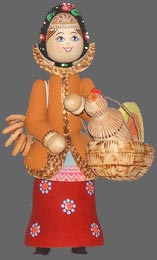
"The girl with the cock"
Tver toy. 2003
|
The
contemporary craftsmen and artists are actively studying
and mastering the traditions, skills and manufacturing processes
typical for the folk arts and crafts of their regions. The
“Maiolika” company in the city of Yaroslavl
has made a sustained effort in this direction. The team
of craftsmen headed by designer N.Pavlova developed a range
of unique majolica articles. They started with making the
common earthenware whistles made of red clay. Later they
coated, the whistles with opaque white glazing and painted
them in many colors. The motifs of the Yaroslavl majolica
whistles and rocking toys are rooted in the ancient carnival
culture of Russia.
The centers of the Russian
toy-making trade strive to retain the traditional styles
and motifs but simultaneously they are seeking for a niche
in the new market economy and respond efficiently to the
market demand.

"Bear with honey-tub". Honey-jug
Yaroslavl majolica. 2004
|
Several
workshops have been established recently where teams of
artists and craftsmen collaborate in producing new types
of Russia hand-made toys working in the spirit of the 19th
century arts-and-crafts cooperatives.
Designer Galina Maslennikova
(Moskow) is one of the most famous Moscow artists of doll
design. She is manufacturing highly original dolls dressed
in the traditional costumes of the various regions of Russia
of the XIX century. These dolls continue the traditions
of the folk-art dolls and of the 19th-century artists who
designed dolls in ethnographic costumes at the Moscow workshop
"Children's education". Galina Maslennikova continues
the tradition of ethnographic dolls as a modern artist who
has received a thorough professional training. Galina Maslennikova
is a member of the International Artist Guild. In 1992-1997
she participated in many Moscow and international exhibitions
(in France, Canada, USA, Germany and Austria).
In 1990 Galina Maslennikova
founded the "Russian Dolls" studio, where she assembled
about 50 Russian folk craftsmen and professional artists:
dress designers, sculptors, ceramics masters from Moscow,
engravers and masters of decorative painting from Sergiev
Posad, Nizhny Novgorod and Vladimir, masters of traditional
russian crafts of bast-shoes weaving and felt boots manufacture.
With linen and wool shawls from Pavlov Posad, brightly painted
musical instruments, thick woolen felt boots and hand-woven
shoes, Galina's creative details invoke the unique flavor
of Russian folk tales and turn of the XIX century customs.

"Old man with his good-wife"
Studio of Galina Maslennikova
|
The
toy-making tradition of Saint-Petersburg can be traced back
to the time when the city was founded 300 years ago. Before
the region was taken over by the Russian Empire the local
Ugro-Finnish communities had manufactured dolls for the
everyday life purposes and for use in the ancient sacred
rituals. Peter the Great, the founder of Saint-Petersburg,
established the city as a center of West European culture
an therefore the Russian folk art did not develop there
as fast as in other regions of Russia. The urban-style dolls
made in Saint-Petersburg were manufactured of expensive
materials and were intended for the decorative purposes
as interior furnishings. Doll makers lived mostly at Okhta
a suburb of Saint-Petersburg, and their favorite subjects
were figurines of noble ladies, high society beauties, hussars,
and other military officers. Starting from the late 20th
s of the 19th century the demand for dolls grew sharply
as the demand for dolls and other toys for children increasingly
grew from the families of different social classes. The
number of doll makers grew accordingly. The Handicrafts
Museum in Saint-Petersburg had an extensive collection locally
made dolls.
The toy-making tradition of
Saint-Petersburg can be traced back to the time when the
city was founded 300 years ago. Before the region was taken
over by the Russian Empire the local Ugro-Finnish communities
had manufactured dolls for the everyday life purposes and
for use in the ancient sacred rituals. Peter the Great,
the founder of Saint Petersburg, established the city as
a center of West European culture an therefore the Russian
folk art did not develop there as fast as in other regions
of Russia.
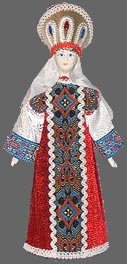
"Boyar's daughter"
Saint-Pétersbourg. 2004
|
After
the revolution of 1917 the private toy-making workshops
were nationalized and one of them is still in existence
bearing the "Igrotekhnika" Factory.
In early 90s of the 20th century
the doll-making trade was
revived. The graceful appearance of the "urban-style"
dolls brings back the cozy atmosphere of the rich Russian
country states of the past centuries. The "Poteshny
proomysel" company in Saint-Petersburg is the major
manufacturer of dolls dressed in ethnic and high-society
costumes typical for different historic periods and nations.
Their most popular products are the sets of dolls sold under
the titles the "Tsar Dynasty", which includes
dolls of all Russian tsars from Peter the Great to Nicholas
II, and "Historic personages", which includes
the dolls of famous Russian statesmen and field marshals
Suvorov and Kutuzov.
The small-size dolls are very carefully executed, sometime
have porcelain parts (heads and hands), and have a considerable
artistic value.
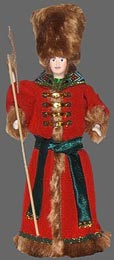
"Strelets" (Body-guard of Tsar)
Saint-Pétersbourg. 2003
|
|